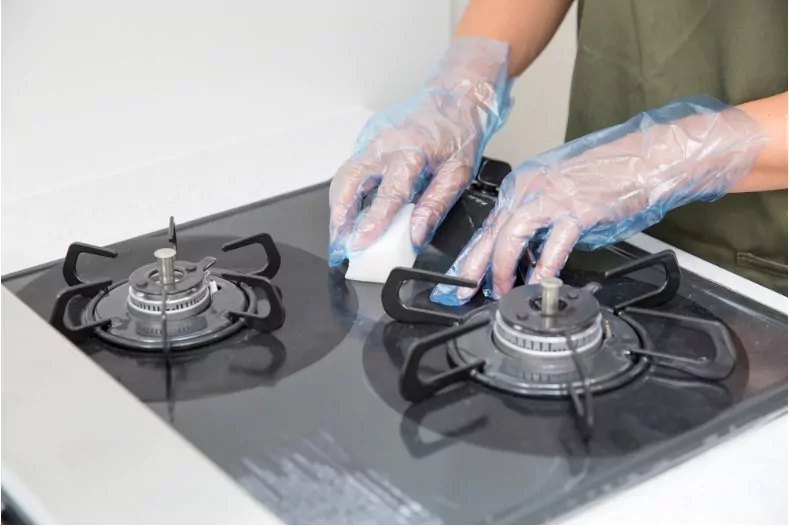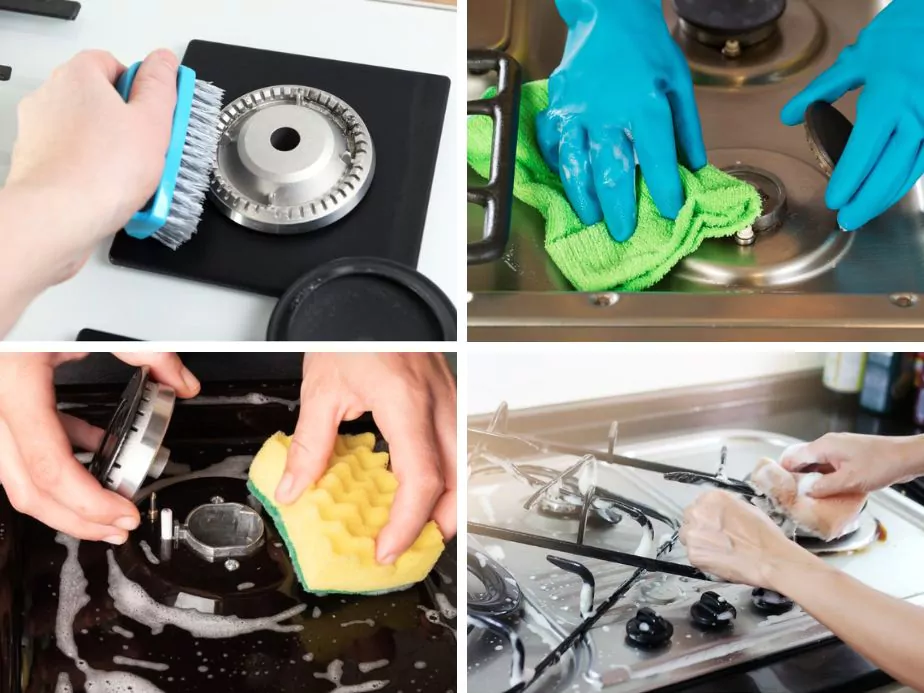How To Clean A Gas Stove? Tips and Tricks

A gas stove is an indispensable household item for many, especially those who cherish the joy of cooking. However, the aftermath of a delicious meal often leaves the stove looking dirty with spills, grease splatters, and burnt food particles. If you’ve been wondering how to clean a gas stove or specifically, how to clean gas stove burners, then this guide is for you. We’ll delve deep into cleaning every nook and cranny of gas stoves, ensuring that the shine and performance of your stovetop remain intact.
1 Why Clean Your Gas Stove?
Before we jump into the nitty-gritty, let’s understand why it’s essential to keep your gas stove clean. A clean gas stove not only looks aesthetically pleasing but also operates more efficiently. Food particles and grease can clog the burner head, causing an uneven flame or sometimes preventing the burner from working altogether. By regularly cleaning, you can extend the life of your gas stove and ensure a safer cooking environment.
2 Step-by-step Guide to Clean Gas Stoves, Gas Burners and Grates

- Cool Completely: Before starting any cleaning process, ensure that all the parts of the gas stove, especially the burners and grates, cool completely. Working on a hot surface can lead to accidents.
- Preparation: Remove the grates, burner caps, and burner heads from the stovetop. Most gas stoves allow you to lift these parts easily.
- Loose Debris: Start by removing loose debris from the stovetop. Use a soft cloth or brush to wipe away crumbs and other particles.
- Dish Soap & Warm Water: In a sink, prepare a mixture of warm water and dish soap. Dip a clean cloth in this soapy water and wipe down the gas stovetop surface. This will take care of the initial layer of grime and spills.
- Gas Stove Burners & Burner Caps: Place the burner parts in a bowl or sink filled with soapy water. Allow them to sit for a few minutes. Using a toothbrush, scrub the burner heads and caps gently to remove stubborn stains and food residues.
- Gas Stove Grates: For tough stains on gas stove grates, a little elbow grease might be required. Scrub the grates with soapy water. Baking soda can be a great ally in this process. Mix baking soda with water to form a paste, apply it to the grates, let it sit, and scrub away. Baking soda acts as a natural stovetop cleaner, efficient in breaking down tough stains without the need for harsh chemicals.
- Rinse & Dry: After scrubbing all the parts, rinse them thoroughly with hot water to remove any soapy residue. Make sure to dry them completely before reassembling them to prevent any rust or unwanted reactions to the gas.
- Drip Pans: If your gas stove has drip pans, remove and wash them with hot soapy water. For tougher stains, a mixture of half water and half vinegar can be sprayed on the pans. Let it sit for a while, then scrub it away.
- Final Touch: Once everything is cleaned and dried, reassemble all the parts. Wipe the entire stove one last time with a clean cloth to ensure no residue remains.
3 Additional Tips for a Deep Clean
- Vinegar Spray: For those who want a natural cleaner, vinegar acts as an efficient stovetop cleaner. Mix equal parts water and vinegar in a spray bottle. Spray it over the surface or grates and let it sit for a few minutes before wiping it off.
- Avoid Sharp Objects: Refrain from using sharp objects to scrape off food. This might lead to scratches on the surface or damage to the burner parts.
- Glass Cooktop: If your gas stove comes with a glass cooktop, avoid scrubbing too hard. Use a specialized cleaner and ensure you wipe it with a soft cloth.
- Stay Ahead of Spills: To decrease your working time during deep cleaning, try to clean spills as soon as they happen. This prevents them from becoming stubborn stains.
4 Personal Preference and Safety
Some individuals may have a personal preference for certain household items or commercial cleaners. While there are many specialized cleaners available for gas stoves, remember to read the instructions carefully. Avoid any cleaner that might leave a flammable residue.
Also, while the oven and stovetop are parts of the same appliance, they require different cleaning techniques. Never immerse the electric parts of your stove in water or any cleaning solution.
5 How Often Should You Clean Gas Stove Burners?
Cleaning your gas stove burners regularly ensures they operate efficiently and safely, while also maintaining the aesthetics of your kitchen. The frequency of cleaning can vary based on your cooking habits and the type of meals you prepare. Here’s a guide to how often you should clean different parts of your gas stove:
Daily Cleaning
Light Wipe Down: Every time you cook, it’s a good practice to wipe down the stovetop after it cools to remove any minor spills, splatters, or loose debris. This prevents build-up and makes deeper cleaning tasks easier in the long run.
Weekly Cleaning
- Burner Caps and Grates: If you cook frequently, weekly cleaning of the burner caps and grates is advisable. This can be as simple as soaking them in warm, soapy water, giving them a gentle scrub, and rinsing them.
- Surface Cleaning: A more thorough wipe down of the entire stovetop using a suitable cleaner or a mixture of vinegar and water will help tackle grease and minor stains.
Monthly Cleaning
- Burner Heads: Gas stove burners, specifically the burner heads, should ideally be cleaned monthly to prevent clogging from food particles and grease. A clogged burner can lead to uneven flame distribution and inefficient cooking.
- Drip Pans: If your stove has drip pans, a monthly clean can prevent them from becoming overly grimy and harder to clean down the line.
Deep Cleaning Every 3-6 Months
Depending on your cooking frequency and the type of food you often prepare, a deep clean every 3 to 6 months is recommended. This involves disassembling the burners, grates, and any other removable parts and giving them a thorough clean. It’s also a good time to check the burners for any signs of wear or damage.
For stubborn stains or accumulated grime, using baking soda and vinegar can be quite effective.
As Needed
If there’s a significant spill or overflow, it’s best to clean it as soon as the stove cools. Sugary spills, in particular, can become stubborn and might corrode the metal if left unattended for too long.
If you notice uneven flames or that a burner isn’t lighting up efficiently, it might be clogged and need immediate cleaning.
6 Wrapping Up
A clean gas stove not only ensures efficient cooking but also adds to the aesthetics of your kitchen. With a combination of household items like baking soda, vinegar, dish soap, and a little elbow grease, you can ensure that your gas stove remains as shiny as new. Regularly removing food particles, and grease splatters, and cleaning your gas stove burners will not only enhance the lifespan of your stove but also make your cooking experience more enjoyable. So the next time you spill something on your gas stove, remember that with the right technique, cleaning is just a few wipes away!
Community Q&A
About This Article
This article has been viewed 343 times.



